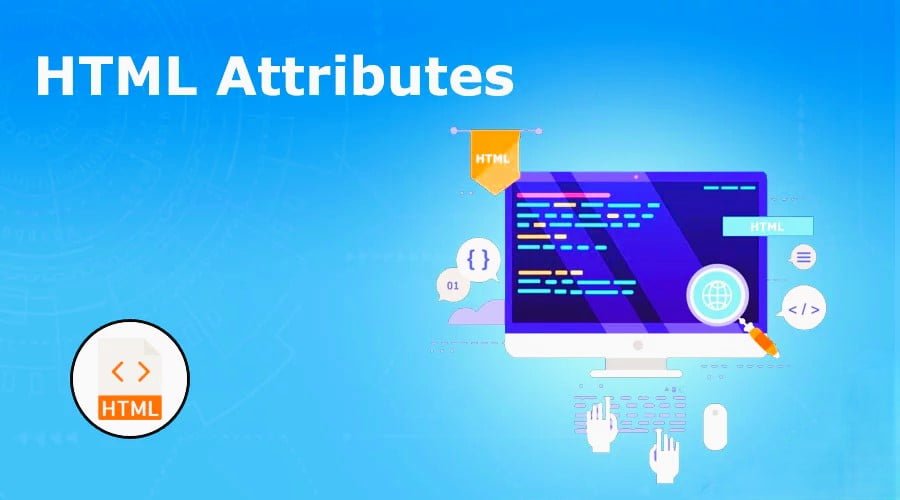HTML Tutorial
- HTML HOME
- HTML Introduction
- HTML Editors
- HTML Basics
- HTML Comments
- HTML Elements
- HTML Attributes
- HTML Headings
- HTML Paragraphs
- HTML Styles
- HTML Text Formatting
- HTML Quotations
- HTML Colors
- HTML Links
- HTML Images
- HTML Favicons: How to Add and Optimize for All Browsers
- HTML Page Title: How to Optimize Titles for SEO Success
- HTML Tables: Create & Optimize for Better Web Design | Codeezy
- HTML Lists: Types, Examples & SEO Tips for Better Structure
- HTML Block and Inline Elements
- HTML Iframes
- HTML File Paths
- HTML Layout
- HTML Computer Code Elements
- HTML Semantics
- HTML5 Semantics
- HTML Entities
- HTML Symbols
- HTML Emojis
- HTML Charsets
HTML Attributes
HTML attributes are essential components that provide additional information about HTML elements, enhancing their functionality and user experience on web pages. By using attributes effectively, developers can control how content is displayed and interacted with, ensuring a more accessible and optimized web experience. This guide will explore the most important aspects of HTML attributes, their usage, and best practices.

What Are HTML Attributes?
HTML attributes are special modifiers used within HTML tags to specify properties, behaviors, and additional details about elements. They are always defined in the opening tag and follow a name/value pair format, such as name="value". Attributes play a crucial role in defining the appearance, functionality, and accessibility of web content.
Key Components of an HTML Attribute
Each HTML attribute consists of two main parts:
- Attribute Name: The identifier of the attribute, which indicates the type of property being set (e.g.,
id,class,src). - Attribute Value: The specific value assigned to the attribute, which determines the behavior or appearance of the element (e.g.,
header,intro,image.jpg).
Common HTML Attributes and Their Usage
1. `id `Attribute
The id attribute assigns a unique identifier to an HTML element, making it easy to target specific elements for styling with CSS or scripting with JavaScript.
Example:
<h1 id="header">Welcome to My Website</h1>
2. `class `Attribute
The class attribute allows you to group multiple elements under a common identifier, which can be styled collectively using CSS or manipulated with JavaScript.
Example:
<p class="intro">This is the introduction paragraph.</p>
3.` src `Attribute
The `src` attribute specifies the URL of an external resource, such as an image, video, or script. It is commonly used with elements like `<img>`, `<video>`, and `<script>`.
Example:
<img decoding="async" src="image.jpg" alt="A beautiful landscape">
4.` href `Attribute
The `href`attribute is used with anchor (`<a>`) elements to define the destination URL of a hyperlink. Adding target="_blank" opens the link in a new tab.
Example:
<a href="https://www.example.com" target="_blank">Visit Example</a>
5.` alt `Attribute
The `alt ` attribute provides alternative text for images. It is essential for accessibility, as it describes the image to users who cannot view it, such as those using screen readers.
Example:
<img decoding="async" src="logo.png" alt="Company Logo">
6.` title ` Attribute
The `title` attribute provides additional information about an element, which is typically displayed as a tooltip when the user hovers over the element.
Example:
<h3 title="This is a tooltip">Hover over me!</h3>
7. `style ` Attribute
The `style` attribute allows you to apply inline CSS styles directly to an HTML element, defining its appearance without needing an external stylesheet.
Example:
<p style="color: blue; font-size: 18px;">This is a styled paragraph.</p>
8.` lang `Attribute
The `lang` attribute specifies the language of the content within an element, which is crucial for accessibility tools and search engines.
Example:
<p lang="en">Hello, world!</p>
Meta Tag Attributes
Meta tags provide metadata about the HTML document, influencing browser behavior, search engine optimization (SEO), and content formatting. They are placed within the `<head>` section of the HTML document.
Common Meta Tag Attributes:
`charset`: Specifies the character encoding (e.g.,`UTF-8`).`name`: Defines the name of the metadata (e.g., `description`).`content`: Provides the value for the specified name (e.g., a description of the page).`http-equiv`: Sets an HTTP header for the content, useful for browser compatibility.
Example:
<meta charset="UTF-8">
<meta name="description" content="A comprehensive guide to HTML attributes.">
Best Practices for Using HTML Attributes
- Use Descriptive Values: Choose meaningful names and values that clearly convey the purpose of the attribute.
- Optimize for Accessibility: Always include attributes like `
alt`, `lang`, and `title`to improve the accessibility of your content. - Minimize Inline Styles: While the `
style`attribute is convenient, prefer external CSS for better maintainability and cleaner code. - Validate Your HTML: Use tools like the W3C HTML Validator to check for errors or omissions in your attributes.
Conclusion
HTML attributes are powerful tools that enhance the functionality, appearance, and accessibility of your web pages. By understanding and applying these attributes correctly, you can create more robust and user-friendly websites. Whether you’re linking to external resources, styling elements, or ensuring accessibility, HTML attributes are an essential part of your web development toolkit.
Frequently Asked Questions (FAQs)
What is an HTML attribute?
An HTML attribute provides additional information about an HTML element, defined in a name/value pair within the opening tag.How does the `
id`attribute differ from the `class`attribute?
The `id`attribute assigns a unique identifier to an element, while the `class`attribute groups multiple elements under a common identifier.Why is the `
alt`attribute important?
The `alt`attribute improves accessibility by providing alternative text for images, which is essential for users who cannot view the image.Can I use multiple attributes on a single element?
Yes, multiple attributes can be applied to a single HTML element, each serving a different purpose.
Thank You for Visiting Codeezy.org!
We’re thrilled to have you as part of our coding community. Your engagement and support inspire us to continue providing high-quality resources and tools to enhance your web development journey. Whether you’re a beginner or an experienced coder, we hope you found valuable insights and tools here at Codeezy.
Stay connected for more tips, tutorials, and updates to help you code with ease. Thank you for choosing Codeezy.org—your growth as a developer is our motivation!
Happy coding!
